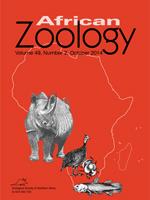We investigated ecological separation through dietary partitioning of small mammals in the nutrient-poor Fynbos biome using a stable isotope approach. Hair samples from eight species of co-occurring small mammals in two separate locations were analysed for stable carbon (13C/12C) and nitrogen (15N/14N) isotope ratios. In addition, we investigated the seasonal variation in diet again by using variation in isotopic composition of one of the most common small mammal species, the Cape spiny mouse. We also analysed seeds and leaves from the most common plant species at each study site. Results showed that some dietary separation exists among these coexisting small mammals. Geographic differences exist in isotope signatures within the Cape spiny mouse, possibly resulting from area-related variations in isotope values of plants, as well as differences in the animals' diets. A. subspinosus hair shows little to no seasonal fluctuation of isotopic signals, except in summer, which possibly indicates a stable diet over much of the year. We conclude that the isotopic approach to determine trophic levels is limited by significant geographic variation in plant isotopes and enrichment in seeds compared to leaves.
BioOne.org will be down briefly for maintenance on 12 February 2025 between 18:00-21:00 Pacific Time US. We apologize for any inconvenience.
How to translate text using browser tools
1 October 2014
Towards an Isotope Ecology of Cape Fynbos Small Mammals
Irene M. van den Heuvel,
Jeremy J. Midgley
ACCESS THE FULL ARTICLE

African Zoology
Vol. 49 • No. 2
October 2014
Vol. 49 • No. 2
October 2014
Cape Fynbos
Cape spiny mouse
interspecific competition
isotope ecology
small mammals




